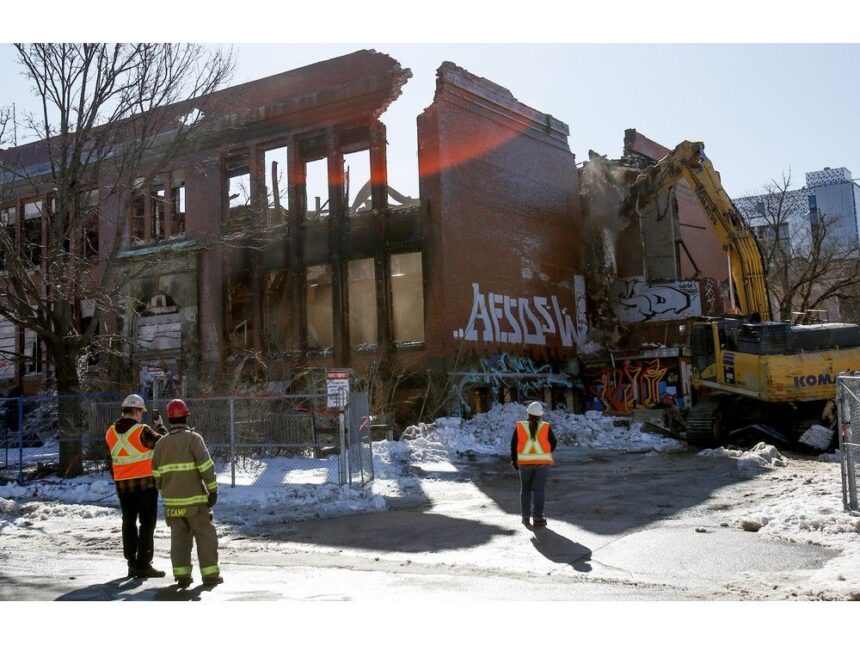Published Apr 12, 2025 • Last updated 18 hours ago • 5 minute readThe process of knocking down the former Bloomfield School in Halifax begins Feb. 19. The property was struck by fire the previous weekend and the unstable structure was being knocked down with an excavator. Photo by Tim Krochak /The Chronicle HeraldTwo abandoned Halifax public schools, Saint Patrick’s Alexandra and Bloomfield, stand in near ruins as sad reminders of recent public policy failures.Cast aside by the Halifax Regional School Board as casualties of progress, left derelict for years, they are now derided as “eyesores” and “a danger to the neigbourhood.” Twelve fire calls over the past year, including two in late March, awakened everyone to the dangers.THIS CONTENT IS RESERVED FOR SUBSCRIBERS ONLY.Subscribe now to access this story and more:Unlimited access to the website and appExclusive access to premium content, newsletters and podcastsFull access to the e-Edition app, an electronic replica of the print edition that you can share, download and comment onEnjoy insights and behind-the-scenes analysis from our award-winning journalistsSupport local journalists and the next generation of journalistsSUBSCRIBE TO UNLOCK MORE ARTICLES.Subscribe or sign in to your account to continue your reading experience.Unlimited access to the website and appExclusive access to premium content, newsletters and podcastsFull access to the e-Edition app, an electronic replica of the print edition that you can share, download and comment onEnjoy insights and behind-the-scenes analysis from our award-winning journalistsSupport local journalists and the next generation of journalistsRegister to unlock more articles.Create an account or sign in to continue your reading experience.Access additional stories every monthShare your thoughts and join the conversation in our commenting communityGet email updates from your favourite authorsSign In or Create an AccountorArticle contentAbandoned by the Halifax school system, the two derelict north-end buildings, once treasured by students as repositories of school-day memories, revived for a time by community action groups, fell into the hands of developers and are undergoing or threatened with demolition.Saint Pat’s AlexandraIn March 2009, the Halifax Regional School Board voted 5-3 to close Saint Pat’s Alexandra School and save the tiny Saint Mary’s School in the south end. Attendance at the Primary-to-Grade 9 school with a capacity of 800 declined from 138 in 2007-08 to 80 in 2008-09. It was one of the board’s innovative Africentric learning schools, headed by a Black principal.Since its opening in 1921, the school served as an educational beacon in Halifax’s tightly woven north-end community. Serving mostly African Canadian students, the school exuded the history and values of the Black community. Plaques bearing the names and portraits of notable citizens hung in the halls.Article contentClosing Saint Pat’s Alexandra was fiercely debated in a series of accommodation review meetings with community members and local representatives. Social problems in the neighbourhood contributed to the decline in students and tipped the balance in favour of closure.It was a tough decision for then-board chair Irvine Carvery, a local resident, especially when the initial plan called for it to be turned into condominiums. A former student of Saint Pat’s Alexandra, Kadeem Hinch, interviewed in July 2009, raised concerns about neighbourhood kids being moved to Joseph Howe Elementary School, south of North Street.Abandoned school in limboA fateful decision was made in 2009-10 when the board made the call to abandon its original headquarters at Dartmouth City Hall. One of the options seriously considered, then ruled out, was moving the central office to the old Saint Patrick’s building.Converting surplus schools into offices and decentralizing operations was common across Canada, beginning in the cost-conscious 1990s. Yet the relocation to Saint Pat’s, reasonably close to the Department of Education headquarters, was brushed aside in the move to a larger, more palatial headquarters in Dartmouth.Article contentA tug of war emerged over the redevelopment of the Saint Pat’s site. The school and the property were eventually sold to Jono Developments in 2016 for $3.4 million, after a lengthy legal dispute over zoning and proposed use of the premises. Community groups, including the North Central Community Council Association, challenged the sale in court but, after two sets of proceedings, the Nova Scotia Court of Appeals ruled in the developer’s favour.Groups pushing for redevelopment incorporating affordable housing and community use spaces did not relent, and the developer sat on the property, leaving it in limbo for a decade. That allowed it to fall into deplorable derelict condition. Students gather on the steps of Saint Patrick’s Alexandra School in June 2011. The Halifax school closed for good at the end of the school year. Photo by Tim Krochak /The Chronicle HeraldImagine Bloomfield debacleThe historic and long-abandoned Bloomfield School at the corner of Agricola and Almon streets suffered a similar tragic fate. Damaged by fire in February, it was another sorry tale of public policy failure at all levels. Like Saint Pat’s Alexandra, the old building had been left in limbo for years.Article contentThe board declared the school surplus in 1988, and the Bloomfield Centre was converted into a community centre and neighbourhood hub housing groups and community outreach agencies. Calls for it to be demolished in the early 2000s were staved off by activists with a visionary plan known as Imagine Bloomfield to transform the site into a “sustainable community arts centre.” That plan and a few others died as the fate of the property was punted among HRM, the province and private developers.Imagine Bloomfield’s vision looked promising for Susanna Fuller and its proponents back in 2012, when HRM hired architects to produce a master plan. Halifax council approved a $100-million redevelopment plan to be undertaken by the Nova Scotia Housing Development Corp. — now Housing Nova Scotia — the provincial government’s affordable housing agency. The agency bid $15 million for the 1.5-hectare property and proposed a mix of market-rate housing with 40 per cent affordable units.Article contentThe “game changer” went for naught when the sale was never completed. By 2016, when Halifax was left spending $11,000 a month to maintain the vacant buildings, Housing Nova Scotia backed out of its Bloomfield plans. The province’s then-community services minister, Joanne Bernard, eventually pulled the plug on the whole project.While HRM was weighing its options, the Conseil Scolaire Acadien Provincial (CSAP) stepped up in 2017, proposing it as the site for a P-12 school on the peninsula. A year later, the province passed — for the second time — on buying the former Bloomfield School, despite CSAP’s interest. The provincial TIR department put the kibosh on that proposal, raising concerns about the small size of the site and the safety risk from traffic on nearby streets.Eventually, that site too was turned over to developers. In 2021, Alex Halef of the BANC Group bought the Bloomfield property from HRM for $22 million. Two years later, Halef reported to an municipal committee that it would cost him $2 million to demolish the vacant buildings and that explained the delays. Facing many complaints about debris around the building, holes in the fence and trespassers breaking windows, he delayed taking action, blaming trespassers for the state of the structure. It was a fire trap waiting to happen.Article contentDesecration of public propertiesAbandoned schools are too often sadly neglected and cast aside as orphans. That’s the real moral of this sad story. School authorities, the municipality and the province all fumbled the ball in failing to plan for, and complete, the transition to alternative uses responding to community aspirations or the needs of our most underserved citizens.Housing and affordability are two of our most pressing public concerns, and the management of these two public properties is nothing short of a disgrace. With more people living rough, it’s abundantly clear these sites should have been repurposed long ago to help meet the need for more affordable housing and reduce the prevalence of encampments.Let’s hope that the fire-scarred ruins serve as a wake-up call for Mayor Andy Fillmore, regional council, the school district and the province.Paul W. Bennett is director of the Schoolhouse Institute, instructor in the graduate education program at Saint Mary’s University and senior fellow with the Macdonald-Laurier Institute. He’s also author of Vanishing Schools, Threatened Communities: The Contested Schoolhouse in Maritime Canada (2011).Article content
PAUL W. BENNETT: Learn from the sad history of Nova Scotia’s abandoned schools












